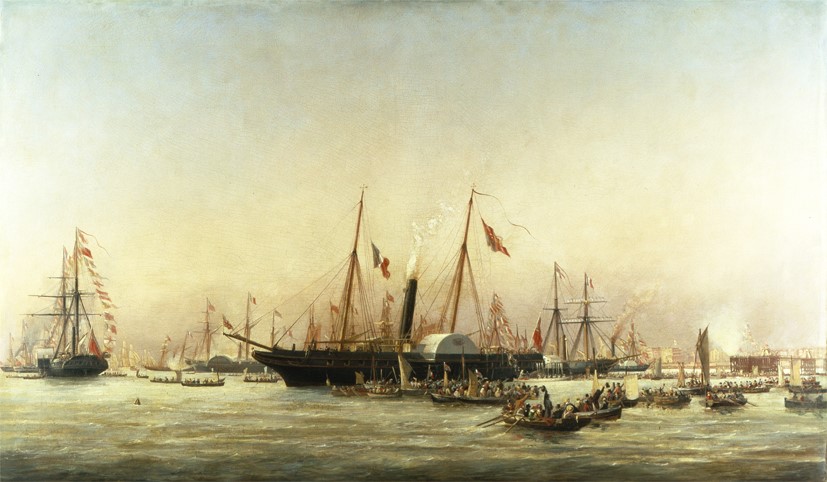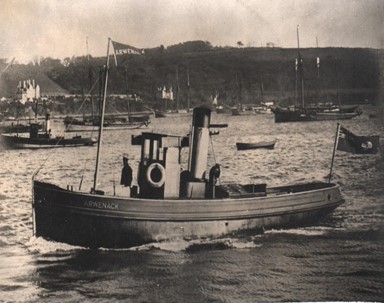
Lockdown updates
28 October 2020
Weathering the Storm
10 May 2021Captain Nichols’ account of the sinking of the Duke William is corroborated by a variety of other sources.
Lloyd’s List, then the twice weekly British Shipping newspaper, of Tuesday 22nd November 1757, reported the Duke William, commanded by Captain William Nichols, as arrived off Gravesend on Thursday November 17th. The Duke William, of Great Yarmouth, had just returned to the River Thames, from Halifax after a lengthy Newfoundland voyage. Records of the payment of ‘Seamen’s Sixpences – an establishment sick fund for seamen- show that her crew for that voyage had signed on in mid February.1 She had sailed for Halifax, Nova Scotia, shortly afterwards, clearing from the Downs, the anchorage off Deal, for America on March 4th 1757.2 On the close of this voyage the last man was paid off again on 21st November 1757.3 So Nichols and his ship had been to the Americas before.
A quick check of these records shows that the Duke William, of Yarmouth4, was previously engaged in the ‘Peterbr’o‘ trade, probably as an East Coast collier. These records were primarily to record & ensure payments into the fund at 6d. per man/month (lunar) for each member of the crew of a ship. The first two entries give the ‘Numb. of Men ufually Sail’d with’ as ‘16.’ However, for her 1757 voyage she is noted as ‘of London,’ and of ‘300’ tons, with a crew of 21 men which ties in quite closely with the numbers given in Captain Nichols’ account of her final voyage in 1758. There is no record here of this final voyage: it not being completed.
Previously, in October 1756, Captain William Nichols, ‘of Yarmouth in the County of Norfolk‘, had applied for, and been granted, a Letter of Marque, to sail the Duke William as a privateer and take reprisals from the French. His application gives her tonnage as ‘about four hundred‘,5 carrying a crew of 22 men, and armed with 10 carriage guns – of unstated size but probably four or six-pounders – and 8 swivel guns, besides small arms and ammunition. Granted on October 2nd 1756, William Nichols, Mariner, and ‘William Butcher of Great Yarmouth Gentleman’, were named as her owners.6 Whether she was ever an active privateer is uncertain, but such a licence would allow her to sail without convoy if the occasion arose.
During her brief sojourn on the Thames, December–January 1757-8, as part of the general Anglo-French conflict, the British Government was assembling an expeditionary force to be sent across the Atlantic to wrest Louisbourg, Nova Scotia, from the French. An essential key to the success of this expedition was finding enough suitable vessels to act as transports for the troops and supplies, and the Duke William was just one of a number of similar vessels, of about 300 to 400 tons, which were hired for this purpose.
Assembling a large number of such vessels took time, and required a suitable rendezvous which, for such a voyage this, would preferably have been in the west of the British Isles. Carrying troops and essential supplies, these transports would have sailed in convoy, with a substantial escort of RN warships. Initially the transports assembled at Spithead, where Nichols says the Duke William lay at anchor for some time before they sailed for Ireland.
Cork was the chosen port of final rendezvous, where they were to embark troops and their equipment. On January 31st 1758, the transports sailed from Portsmouth for Cork, under a naval escort led by Captain Pigott in HMS York. Their passage down Channel and across the Irish Sea was no quick dash, but a more stately progress, and shortly before their arrival at Cork they encountered thick fog, in which the Duke William lost touch with the rest of the fleet. Driven up to Waterford and embayed by rocks, she failed to get down to Cork for another three weeks, while Lloyd’s List of Tuesday 24th February reported the arrival of the main fleet at Cork on February 12. Then comprising:
- York Man of War from Portsmouth
- Tryton, Goad, from Portsmouth
- Nazaretta, Kennedy, from Portsmouth
- Prince of Wales, Putty, from Portsmouth
- Two Brothers, Stockdale, from Portsmouth
- Mary, ?, from Portsmouth
- June, Walker, from Portsmouth
The timing is imprecise, but from Captain Nichols’ comment in his memorial of the voyage, the Duke William would have made Cork about the evening of March 7th. She must have been the last of the transports to arrive at the rendezvous and Nichols’ delay in making the rendezvous brought down upon him the vehement ire of Captain Pigott. Unfortunately Nichols does not date the events recounted in his memoir. His ‘cargo’ of troops was brought off to him the next morning, and it would appear that the transport fleet sailed from Cork the day after his arrival off that port.
Their sailing was reported in Lloyd’s List of Tuesday 21st March – ‘Cork 9th. – Sailed York Man of War with five transports for America.’ The actual number of transports that sailed with this expeditionary force is not certain. It must have been considerably more than five. Amongst those noted by Captain Nichols are several not listed above amongst those that arrived at Cork on February 12th – including Anna Maria; Parnassus, Johnson; Yarmouth, Hurry; and the Violet, Sugget. Nichols also names several other transport masters, implying a transport fleet of at least a dozen or more vessels. He also records that nine transports were ordered to carry the French civilians deported from Acadia to Old France.7
Nothing more is reported in Lloyd’s List, about the progress of the transport fleet, or the expeditionary force, until Friday August 18th, when they announce:
‘French Men of War taken and destroy’d in the Harbour of Louisburg, which surrendered to His Majesty’s Arms the 26th of July last, Viz.
Taken, The Celebre of 64 Guns, the Apollo of 50, and two Frigates of 36 Guns each.
Burnt. The Prudent and Entreprenant of 74 Guns each, with the Capricieux and Bienfaisant of 64 Guns each.
Sunk by the French themselves, three Frigates.’
Lloyd’s List, Friday 18 August 1758
Again there is a long period of silence before a final report:
‘The Duke William, Nichols, a Transport from Louisburgh, founder’d at Sea, but the Crew are arriv’d at Penzance in their Boat.’
Lloyd’s List, Friday 22 December 1758
The same brief report was carried by the Sherborne Mercury, a contemporary Westcountry weekly newspaper, of December 25th, and was either submitted by the same correspondent, of culled from the above Lloyd’s List.
Some questions remain.
Where did the Duke William founder?
Given the number of days they had been running on dead-reckoning, any position given for the Duke William’s foundering must have been wildly inaccurate. Given the state of their boats, they would not have travelled very far each day. Say 5 days at 4 knots, equals under 100 miles per day, or 500 miles. At 3 nautical miles per league, equals say 170 leagues off Mount’s Bay. Or about 150 leagues West of the Isles of Scilly.
The boat which carried the four Acadians into Falmouth was a third boat.8 The ship’s ‘jolly boat’ or dinghy – a boat of perhaps 10 or 12 feet in length, and discounted as a means of saving life by the crew. For them to have reached Falmouth ‘within two days,’9 suggests that the Duke William was much closer to the British coast than Nichols reports. Probably little more than 50 leagues, or quite close to the Isles of Scilly.10
Was the Duke William sound?
There is no reason to suspect otherwise. Unfortunately there was no formal registration of vessels in that period, so we do not know when or where she was built. However, as a hired transport she would have had to meet quite demanding standards before the Navy Board would take her on. In theory it should be possible to discover the terms under which she was hired, but it would take an extensive search of the Navy Board records to discover this. I don’t think she was unseaworthy as such, but her bottom would have been foul after eleven months at sea, impeding her sailing abilities.
Where happened to the affidavits?
If they survive, I would expect these affidavits to be held by the National Archives, in Class HCA = High Court of Admiralty. But this is a very large class of material dealing with all points of British law on the High Seas. So far I have not been able to trace them. George Veal [Veale], who took the affidavit depositions, was a Penzance attorney, notary public, and also a Commissioner in several British Courts – certainly Exchequer; & King’s Bench; and probably Admiralty and others. As above, if anywhere they will be with the records of the Court in question in the National Archives – Kew. It would take a major search to find them – assuming they have survived.
What happened to Captain Nichols?
The fate of Captain Nichols is unknown. An unsubstantiated report for September 25th 1769, implies that a William Nichols was appointed to the command of the Falmouth Packet Eagle, on the Corunna service but this seems suspect as the Eagle was then established on the South Carolina run. In 1779 this William Nichols went on to command the Falmouth Packet Swift on the Jamaica run but by now his health was failing.
If this report is correct and this is the same William Nichols – and it is a big if – then William Nichols retired with a pension of £100 pa – the standard pension for a retired packet captain – on 14 August 1782.
Other sources
Curiously, neither the Penzance nor Exeter Custom House Letter-books in the National Archives at Kew, make any mention of Captain Nichols and/or his shipwrecked crew.
I have found no other contemporarily published report of this incident. There is no such report in the London Gazette, which, given that the Duke William was under charter to the Navy Board, is where one would have expected to find such a report.
We have no idea whether Captain Nichols’ journals or diary may have survived, and if so where they might be.
A final question
I am intrigued to know why this report was published in the Naval Chronicles in 1807, nearly 50 years after the event. What caused this belated resurgence of interest? And why was it though necessary to publish this lengthy explanatory account at this time?
Tony Pawlyn
Bartlett Maritime Library and Research Centre Library
- British National Archives [Kew] – ADM 68/199
- Lloyd’s List, Tuesday 8th March 1757
- BNA [Kew] – ADM 68/199
- There are several other Duke William’s but the continuity of dates and master’s name verifies the identity of this one
- Tonnage measurement at this time were extremely vague and variable attempts to assess the cargo carrying capacity of merchant trading vessels – as ‘Tons burthen’
- BNA [Kew] – HCA 26/6 f.35
- See Loss of the Duke William Part 2
- Curiously, no report of this arrival has been found yet, even in the Sherborne Mercury
- See Loss of the Duke William Part 4
- The fate of these sailors is also unknown. One could speculate that they were simply added to the complement of Acadians already resident outside Penryn.
